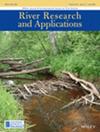人工河礁结构在改善水坝下鱼类栖息地方面的效用
IF 1.9
4区 环境科学与生态学
Q4 ENVIRONMENTAL SCIENCES
引用次数: 0
摘要
为航行、发电、防洪和灌溉而对河流生态系统进行的大规模改造在很大程度上使底栖生物生境单一化,并改变了鱼类的组合。尽管对可涉水溪流和小河流的栖息地恢复和改善技术进行了大量研究,但对于在受水文影响的大河中安装人工鱼类栖息地的潜在作用却知之甚少。由木材或塑料组成的轻质人工鱼类栖息地结构已证明对静态环境中的鱼类数量有影响;但这些结构无法承受大河系统的高排水量和动态水流。戴维斯大坝下的科罗拉多河是受水力影响的代表性生态系统,一天内的放水量可达 2000 至 23,000 立方英尺/秒(56.6-651.3 立方米/秒)。在与多个州和联邦政府机构的协调下,我们部署了一系列混凝土河礁结构,模仿小规模的人工礁石,以增加栖息地的复杂性,并为大流量事件提供河内缓解斑块。底栖生物栖息地覆盖率测量结果与河礁结构部署后 6 个月和 2.5 年的目测调查结果相匹配。广义线性模型表明,鹅卵石增加了河床上方结构的可见度,减少了侵蚀,使鱼类有更大的使用潜力,而沙石(即松散的河床载荷材料)则降低了可见度,导致结构随着时间的推移沉入河床,限制了鱼类的使用。我们的案例研究提供了有关建造人工河礁结构的指导信息和部署建议,并强调了其增加底栖生物栖息地异质性的潜力,对保护和运动鱼类具有重要意义。本文章由计算机程序翻译,如有差异,请以英文原文为准。
Utility of artificial river reef structures to enhance fish habitat below a hydropeaking dam
Large‐scale modification of river ecosystems for navigation, power generation, flood control, and irrigation has largely homogenized benthic habitats and altered fish assemblages. Although riverine habitat rehabilitation and enhancement techniques are well‐studied for wadable streams and small rivers, relatively little is known about the potential utility of artificial fish habitat installation in large rivers impacted by hydropeaking. Lightweight artificial fish habitat structures composed of wood or plastic have demonstrated effects on fish populations in static environments; however, these structures are not able to withstand the high discharge and dynamic flows of a large river system. The Colorado River below the Davis Dam is a representative ecosystem impacted by hydropeaking, where water release can range from 2000 to 23,000 ft3 /s (56.6–651.3 m3 /s) in a single day. In coordination with multiple state and federal government agencies, we deployed a series of concrete river reef structures, mimicking small‐scale artificial reefs, to increase habitat complexity and provide in‐river patches of relief from high‐flow events. Benthic habitat cover measurements were paired with visual surveys of river reef structures 6 months and 2.5 years post‐deployment. Generalized linear models indicated that cobbles increased structure visibility above the riverbed, displayed less erosion, and allowed for greater potential fish use, whereas sand and gravel (i.e., loose bedload materials) decreased visibility and caused structures to sink into the riverbed over time, limiting fish use. Our case study provides instructional information on the construction of artificial river reef structures and recommendations for deployment, and highlights their potential to increase benthic habitat heterogeneity, with conservation and sport fish implications.
求助全文
通过发布文献求助,成功后即可免费获取论文全文。
去求助
来源期刊

River Research and Applications
环境科学-环境科学
CiteScore
4.60
自引率
9.10%
发文量
158
审稿时长
6 months
期刊介绍:
River Research and Applications , previously published as Regulated Rivers: Research and Management (1987-2001), is an international journal dedicated to the promotion of basic and applied scientific research on rivers. The journal publishes original scientific and technical papers on biological, ecological, geomorphological, hydrological, engineering and geographical aspects related to rivers in both the developed and developing world. Papers showing how basic studies and new science can be of use in applied problems associated with river management, regulation and restoration are encouraged as is interdisciplinary research concerned directly or indirectly with river management problems.
 求助内容:
求助内容: 应助结果提醒方式:
应助结果提醒方式:


